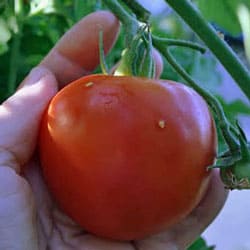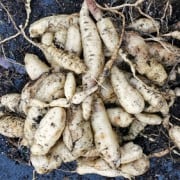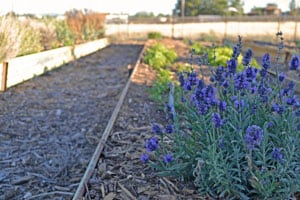Heirloom Tomatoes Have Flavor Lost in Commercial Varieties
Heirloom tomatoes vs standard supermarket “red slicing” tomatoes
One has created a following based solely on its incredible flavor, the other has long been the benchmark of mediocre, tasteless, pithy but brightly colored tomatoes. Available 365 days a year, it’s only offering to the salad or sandwich is a bit of bright red. Why do these universally yucky tomatoes exist, and why do the supermarkets continue to sell such an obviously inferior product?
Consumer demand is the main reason, as most commercial growers state that they are only paid on the weight, not the flavor, of their tomatoes. This traces back to the tomato breeders, as they are responding to the grower’s inputs of what they need – a plant that will yield as much as possible over as long of a time as possible. The fruits must withstand being harvested, packed, and stored in a warehouse where they are turned orange with ethylene gas, then shipped by truck several states away and continue to look good a minimum of 7 – 10 days later when displayed on the grocery store shelves. If the grower has no financial incentive to produce flavor, they won’t.
Here’s a new wrinkle to the story. The growers are not completely at fault, it turns out. Recent research published in the journal Science isolates a gene mutation that is responsible for the almost artificially bright red, at the cost of flavor. This gene mutation was accidentally discovered by commercial tomato breeders and then bred into the majority of tomatoes used in supplying the food chain, especially in the off-season. This is not a genetically modified organism (or GMO) as the gene mutation happened spontaneously, and not through mechanical gene manipulation.
This is truly a story of unintended consequences, as it clearly shows the unwanted results of focusing and breeding too closely on one desired characteristic while ignoring others. The color mutation also turns off the ripening sequence gene, which disables the tomatoes’ ability to manufacture sugar in the body of the fruit, explaining why the lack of flavor. Dr. Ann Powell, a lead author in the Science paper offered this solution to the flavor issue – heirloom tomatoes, as they do not have the genetic mutation!
Flavor Is the Price of Tomatoes’ Scarlet Hue, Geneticists Say









I am currently enjoying the “fruits” of my 25 heirloom tomatoe plants…at least those I can save from the squirrels by picking at frst blush…but I am finding most of them much smaller this year than last. All grown from seed, most are from seeds I have saved although I also added a few new ones to the mix this year. What governs tomato size? Thanks for any input. I just found this site and it looks really wonderful.
Hello Pat! Thanks for the kind comments, and good to hear you are enjoying the heirlooms. Two things that will slow down tomatoes is hot weather and soil lacking the needed nutrients.
Tomatoes are very “hungry” and need a really rich soil to produce the best tomatoes possible. Have you planted the tomatoes in the same spot as last year, or is it a new spot? It is advised to not plant tomatoes or potatoes in the same spot 2 years in a row, mainly to avoid diseases but also to avoid stripping a lot of the nutrients from the soil that takes time to re-build. However, I have also known very experienced gardeners do just this for several years running with great results. They also really paid attention to the soil and heavily amended it during the fall each year.
Read our Compost article for a great introduction to building nutrient-rich soil – http://209.188.88.127/~underwood/668/compost-nourishing-your-garden-soil/.